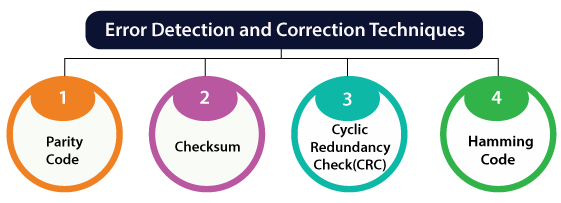Error Detection and Correction CodeError detection and correction code plays an important role in the transmission of data from one source to another. The noise also gets added into the data when it transmits from one system to another, which causes errors in the received binary data at other systems. The bits of the data may change(either 0 to 1 or 1 to 0) during transmission. It is impossible to avoid the interference of noise, but it is possible to get back the original data. For this purpose, we first need to detect either an error z is present or not using error detection codes. If the error is present in the code, then we will correct it with the help of error correction codes. 
Error detection codeThe error detection codes are the code used for detecting the error in the received data bitstream. In these codes, some bits are included appended to the original bitstream. Error detecting codes encode the message before sending it over the noisy channels. The encoding scheme is performed in such a way that the decoder at the receiving can find the errors easily in the receiving data with a higher chance of success. Parity CodeIn parity code, we add one parity bit either to the right of the LSB or left to the MSB to the original bitstream. On the basis of the type of parity being chosen, two types of parity codes are possible, i.e., even parity code and odd parity code. Features of Error detection codesThese are the following features of error detection codes:
Error correction codeError correction codes are generated by using the specific algorithm used for removing and detecting errors from the message transmitted over the noisy channels. The error-correcting codes find the correct number of corrupted bits and their positions in the message. There are two types of ECCs(Error Correction Codes), which are as follows. Block codesIn block codes, in fixed-size blocks of bits, the message is contained. In this, the redundant bits are added for correcting and detecting errors. Convolutional codesThe message consists of data streams of random length, and parity symbols are generated by the sliding application of the Boolean function to the data stream. The hamming code technique is used for error correction. Hamming Code Hamming code is an example of a block code. The two simultaneous bit errors are detected, and single-bit errors are corrected by this code. In the hamming coding mechanism, the sender encodes the message by adding the unessential bits in the data. These bits are added to the specific position in the message because they are the extra bits for correction.
Next TopicASCII Code
|
 For Videos Join Our Youtube Channel: Join Now
For Videos Join Our Youtube Channel: Join Now
Feedback
- Send your Feedback to [email protected]
Help Others, Please Share










